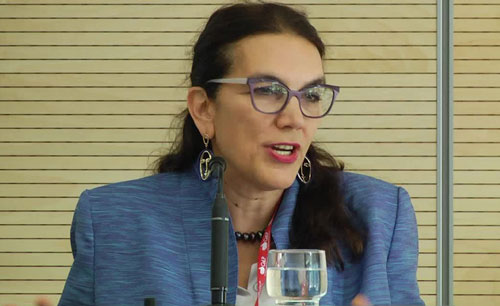Pakistan ‘very safe place’ for tourists: Androulla Kaminara

Islamabad: European Union Ambassador Androulla Kaminara has said that Pakistan, an amazing country with diversity in terms of weather, landscape, biodiversity and a rich cultural heritage, with hospitable and welcoming people, is a ‘very safe place’ for tourists and travelers from across the globe.
“I have been lucky enough to visit some stunning parts of Balochistan, Sindh, KP (Khyber Pakhtunkhwa) and Punjab.
I hope that once the COVID situation improves, I will have many more opportunities to see more of the beauty that this country is blessed with and to interact with as many different people from the cultural diversity of this country,” she said in an exclusive interview with APP on Sunday.
Ambassador Kaminara, who recently visited the Rohtas Fort which is one of the UNESCO World Heritage Sites since 1997, said,” Many of the scenic parts of the country still remain unexplored and that is where the huge tourism potential exists, particularly the stunning northern part of Pakistan with the vast Karakoram mountain range to the coast in the south.”
She said Pakistan was a very safe place to travel and wished that many more tourists and travelers from around the world could have the opportunity to see the beautiful country.
It was a right time and need of the hour to utilize the huge tourism opportunity by introducing the right tourist policies and infrastructural improvement to access the unexplored areas, she added.
“The EU believes that enhancing cultural heritage is an important component – not only for tourism – but also for peace and dialogue,” she said.
Replying to a question regarding the EU role for recognizing the importance of cultural heritage, particularly for tourism, the ambassador said, “Culture plays an important role in the EU foreign policy and is also part of our Strategic Engagement Plan with Pakistan.”
The cultural cooperation, she added, countered stereotypes and prejudice by nurturing dialogue, open-mindedness, dignity and mutual respect.
Culture was an engine for economic and social development, innovation and competitiveness particularly through cultural and creative industries, SMEs (small medium enterprises) and tourism, she remarked.
For the tourism boost in Pakistan, she recommended a comprehensive sustainable strategy focusing on different aspects such as improved access through better road infrastructure, transport and accommodation, besides ensuring cleanliness and protection of natural ecosystems.
Ambassador Kaminara said Pakistan was lucky to have six World Heritage sites on its territory. The Archaeological Ruins at Moenjodaro, Buddhist Ruins of Takht-i-Bahi and Neighbouring City Remains at Sahr-i-Bahlol, Fort and Shalimar Gardens in Lahore, Historical Monuments at Makli (Thatta), Rohtas Fort, and Taxila (Ruins) had a huge potential to attract foreign tourists and visitors, she added.
It was a huge gift and also a very big responsibility, she said. “I have visited some of them. Although a great effort has been made to protect them, more needs to be done. For example, as a tourist it would be very good to be able to buy a book about the history of the site as well as some handicrafts from the area near the site.”
As regards the preservation of artifacts and facilities being provided to visitors at the tourist sites, she said,”More work needs to be done to restore and preserve some of the sites to ensure sustainability – and to work towards protecting these natural attractions from the adverse effects of climate change and the impact it might have on the livelihoods.”
An integrated plan was needed that not only preserved the cultural sites but also provided integrated services to the tourists there, she added.
“A visitor will normally like to buy some souvenirs, eat at a nice restaurant and combine the visit with some sports, other activity or another cultural site.
A visitor normally does not travel to another country just to visit one site, but would like a range of things to do and enjoy.”
